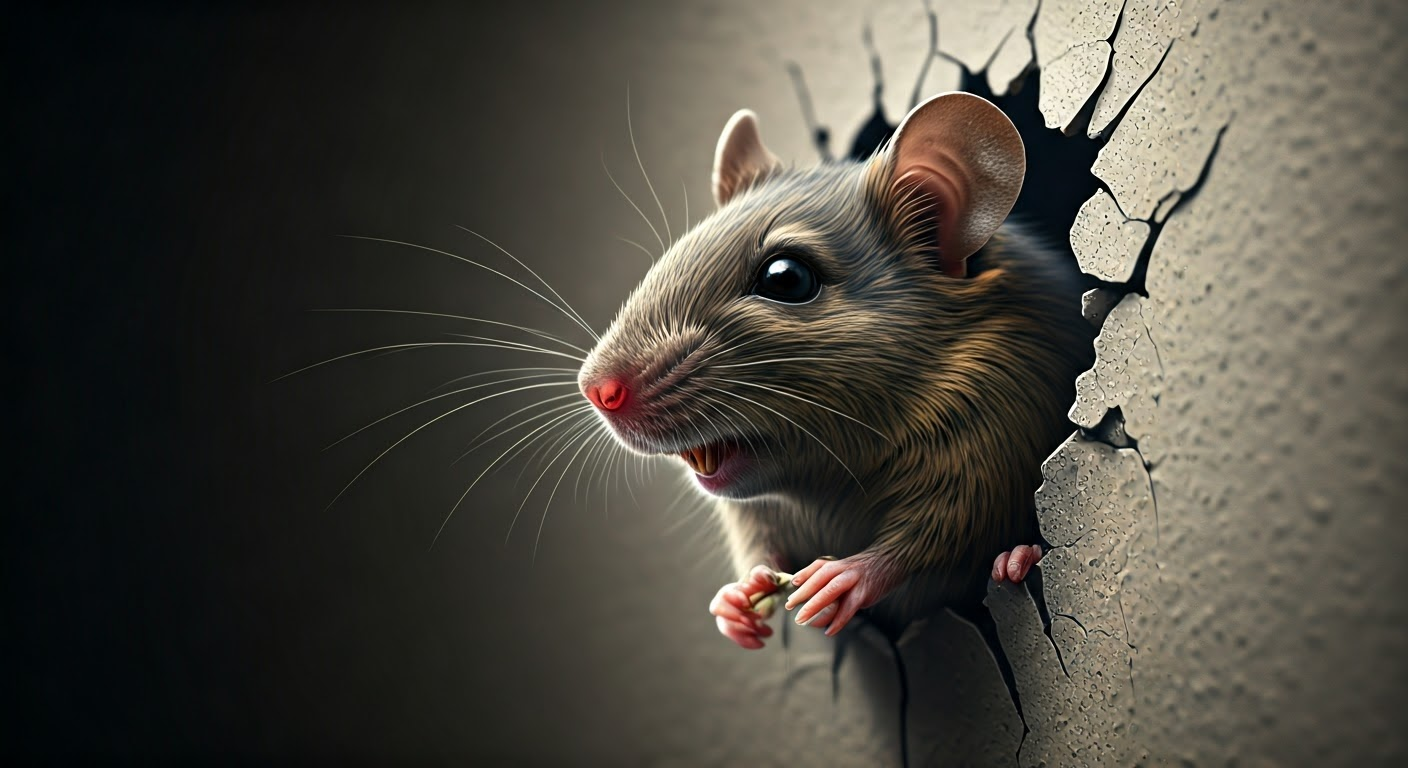If you live on the ground floor or the second floor, you might see a mouse in your home at least once in your life.
Mice can get into your house, no matter if it’s clean or messy. They will always find a way inside and make a spot to live.
You can often find mice inside walls or in tight places like boxes, behind wardrobes, or under the bed. You might want to know how long it takes for a mouse to chew through a wall. This article will give you the answers.
How Long Does It Take A Mouse To Chew Through A Wall?
Mice take a lot more time to chew through a wall compared to rats. A mouse usually spends about 2 to 3 days chewing on and off to get through a wall.
- The type of mouse
- The size of the hole
- The strength of the wall
- The tools the mouse has
- The experience of the mouse
- A mouse will get tired quickly and finish eating faster if it has food and water.
- The material of the wall affects how fast a mouse can chew through it. A heavier wall takes longer to chew through.
- A mouse chews on things to keep its teeth sharp, which can slow down how fast it makes a hole.
- Sometimes they chew just for fun, and that slows them down, too, when chewing through the wall.
- If there are several mice chewing on the walls, it affects the speed.
The most important factor is still the wall material. Here is a list of materials used on the wall and how they influence the chewing process of a mouse.
Concrete
Mice can surprisingly chew through concrete, but only if it is not set properly. If the concrete has too much water compared to cement, a mouse can get through it.
The mouse may not make a hole in the concrete walls. However, it can squeeze through the gaps in the walls or create small openings. Cured or half-cured concrete is soft enough for mice to gnaw through it.
Glass Fibre
Glass fiber is a plastic material, sometimes called FRP. It is known that mice can chew through it. This means that wall panels or coverings made from it are not strong enough to handle the sharp teeth of mice.
Rodents like fiberglass. It makes them feel warm and safe from dangers. Mice use fiberglass walls to make nests and live in them.
You cannot hear a mouse moving inside fiberglass. This makes it a great home for a whole mouse family. Because of this, it’s important to check your fiberglass walls now. You want to make sure there is no mouse infestation.
Drywall
Drywall is made of layers of fiberglass and paper, which is also called gypsum plaster. This shows that drywall is not very strong. Mice can chew through it easily.
In this situation, a mouse can chew through a wall in a very short time.
Drywall is soft and easy for rodents to eat. Mice can easily damage the soft center of these walls by nibbling on them.
Wood
A wooden wall makes it easy for homeowners and pests, like house mice, to get inside. This is especially true if you have small holes or a pest problem in the walls of your home. If there are dead mice, their bodies can make the issue worse. They can create a bad odor because of their strong sense of smell.
Look for signs of mice. The thickness of the wood and the materials used matter. If the wood is thick, it can make it hard for a mouse to chew holes. They usually look for holes the size of a dime. Mice try to get into walls, vents, air ducts, crawl spaces, attic, window frames, and floorboards to search for food in your pantries. However, moisture can make the problem worse. Mice and fleas, along with mouse urine and feces, can damage things. They walk through insulation, hardwood, and cardboard.
To fight this, think about using a good sealant or snap trap. These can help close gaps and stop entry. But this method might take longer. If you have a mouse problem, the best choice is to get professional help. They can remove pests safely. They use techniques like steel wool and live traps. This way, your electrical wiring will be safe, and you won’t need to use poison to deal with the problem.
The wood pieces and shavings are great for mice to build their nests. They can push through these materials and find things to add to their nests. This includes bits of clothing and storage boxes. Because of this, mice prefer wooden walls more than any other type.
Plywood
Plywood is like wood when it comes to mice. It is thinner and smaller, making it easy for mice to bite. Some plywood uses soft materials, which can become wet quickly. This makes it very easy for a mouse to chew through the plywood walls.
Plywood shavings are used to build the mouse’s nest. This makes these walls easy targets for the mice.
How Do Mice Get in Walls in the First Place?
Mice are very clever animals. They can squeeze through small holes, even ones the size of a dime. This skill makes it easy for them to get into homes, usually looking for food or a place to stay. They can enter through different spots, like cracks in the foundation, gaps around doors and windows, or holes in the siding and chimneys.
Once they are inside, they often build nests in the walls, where they feel safe from other animals. To stop a mouse problem, homeowners should check their property often for small openings. They should seal any gaps that might let these pests in.
 How To Prevent Mice From Chewing Through A Wall?
How To Prevent Mice From Chewing Through A Wall?
- Set up mouse traps in your home to catch these pests. Place them in spots where you can easily find any trapped mouse.
- Talk to pest control professionals to help manage these rodent problems in your house.
- Keep your home clean and tidy. Having fewer items will help stop mice from nesting.
- Wildlife experts can help remove a mouse from inside a wall without damaging your home too much.
- Seal any entry points for the mice. This will help stop new infestations from happening over time.
Even if you try to keep your home safe, you may still find mice there. Don’t feel hopeless about it.
What Attracts Mice to Your Home?
Mice are attracted to homes mainly because of food. They will eat almost anything and look for crumbs or leftovers in kitchens and pantries. Even small pieces of food can bring them in. That’s why it’s important to keep your place clean. Any crumbs on the floor, especially near baseboards or countertops, can easily become a meal for these smart animals.
Also, a lot of clutter or hiding spots, like piles of clothes or cardboard boxes, can be good places for them to nest. If you see signs of dead mice or droppings, you should act fast. It’s important to handle the situation before it gets worse.
Frequently Asked Question
How Long Does A Mouse Survive Inside The Walls?
A mouse can live for 2 to 3 months without water. However, without food, it won’t last even a week. If a mouse has food regularly, it will stay near the walls for some time.
How To Know If I Can Find Mice In My Walls?
If you hear squeaking and scratching noises from inside your walls, this could mean you have a mouse problem. The sound of mice is often loud at night, especially in the middle of the night. You might even feel vibrations as the mice move through the walls.
Signs of Mice in Walls
Identifying signs of mice in your walls is important to stop an infestation before it gets worse. Look for mouse droppings. These are small, dark pellets that you may find near food sources or nest areas. Seeing these droppings can mean mice are nearby. Another clear sign is the sound of mice moving behind the walls, mainly at night when they are most active. You might also find gnaw marks on the walls or openings where they get in. If you notice any of these signs, act fast to avoid more damage and health risks linked to mouse infestations.
Conclusion
The time it takes for a mouse to chew through a wall depends on what the wall is made of. If the wall is made of concrete, it will be hard for mice to create a hole. But if the wall is made of glass fiber or plywood, it will be easier for them to chew their way out.
Other things like where mice find food, leftover crumbs, and the available water can affect how long they hang around. Even so, you can keep mice from getting into your house. You can also stop them from chewing through walls.

Hi, I’m Sondip,
I’m a writer who loves to help people solve their problems. I write about small animals like mice and other small animals and even pests.

